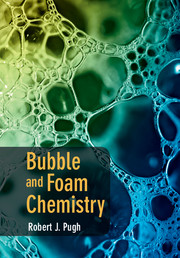Book contents
- Frontmatter
- Contents
- Preface
- Acknowledgments
- List of symbols
- 1 Basic principles and concepts
- 2 The nature and properties of foaming surfactants
- 3 Soap bubbles and thin films
- 4 Processes in foaming
- 5 Generation of bubbles and foams
- 6 Coalescence of bubbles in surfactant solutions
- 7 The stability/instability of bubbles and foams
- 8 Particle-stabilized foams
- 9 Foaming in non-aqueous liquids
- 10 Antifoaming and defoaming
- 11 Bubble size measurements and foam test methods
- 12 Bubble and foam chemistry - new areas of foam research
- Index
- References
9 - Foaming in non-aqueous liquids
Published online by Cambridge University Press: 05 September 2016
- Frontmatter
- Contents
- Preface
- Acknowledgments
- List of symbols
- 1 Basic principles and concepts
- 2 The nature and properties of foaming surfactants
- 3 Soap bubbles and thin films
- 4 Processes in foaming
- 5 Generation of bubbles and foams
- 6 Coalescence of bubbles in surfactant solutions
- 7 The stability/instability of bubbles and foams
- 8 Particle-stabilized foams
- 9 Foaming in non-aqueous liquids
- 10 Antifoaming and defoaming
- 11 Bubble size measurements and foam test methods
- 12 Bubble and foam chemistry - new areas of foam research
- Index
- References
Summary
Nernst was a great admirer of Shakespeare, and it is said that in a conference concerned with naming units after appropriate persons, he proposed that the unit of rate of liquid flow should be called the falstaff.
James Riddick Partington, “The Nernst Memorial Lecture”, Journal of the Chemical Society, Part 3, 2855, 1953.Introduction
Foaming is less commonly encountered in non-aqueous fluids than in water-based media, but it is generally accepted that similar physico-chemical principles are applicable, such as the adsorption to the bubble interface. This enables some analogies to be drawn with aqueous systems but there are problems which need to be resolved, since it was originally thought that the degree of dissociation of solubilized chemical additives was limited in non-aqueous systems and free ions were almost absent. The physical properties of the liquid also play a more important role in determining the stability of the non-aqueous foam, and if one considers the many different types of non-aqueous liquids, for example liquid metals, liquid polymers, crude oils, drilling fluids, lubricants and solvents (base cleaners), then it is clear that wide variations in physical properties need to be considered. With these liquids, distinct differences in, for example, viscosity, conductivity, dielectric constant and density are evident.
This makes it difficult to generalize the prediction of foaming behavior in non-aqueous systems, but usually some type of surface activity is needed as in aqueous systems. For example, in the generation of aluminum foams, silicon carbide particles are added which are captured by the bubbles and act to stabilize the gas/liquid metal interface (1). In mixed hydrocarbon media, lyotropic liquid crystals which are surface-active self-organized assemblies play a role in foaming performance (2, 3, 4). It has also been shown that the addition of inorganic electrolytes to organic liquids inhibits bubble coalescence by reducing drainage, but it is only recently that an improved understanding of bubble stability and interfacial drainage in non-aqueous liquids has been achieved. In these systems, it has been shown that drainage rates may be influenced by the particular arrangement of ions in the interfacial region (5, 6). For non-aqueous liquids with high bulk viscosity such as molten polymers, thick oils and metal foams, the drainage can be relatively slow, and this will reduce the foam decay rate to some degree.
- Type
- Chapter
- Information
- Bubble and Foam Chemistry , pp. 307 - 330Publisher: Cambridge University PressPrint publication year: 2016



